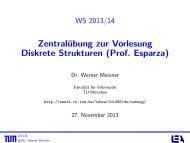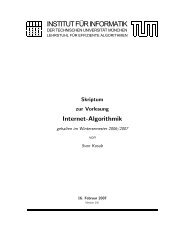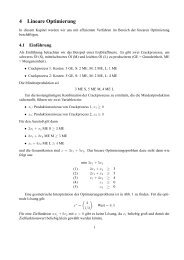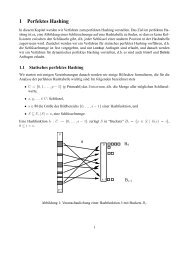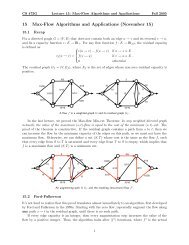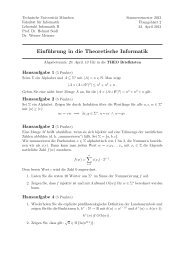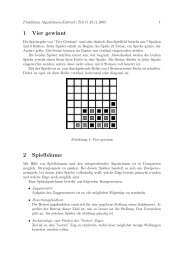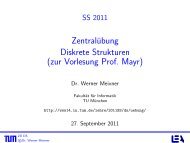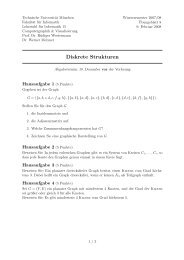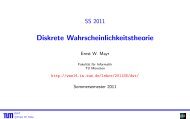ABCDE FGHIJ KLMNO
ABCDE FGHIJ KLMNO
ABCDE FGHIJ KLMNO
- No tags were found...
You also want an ePaper? Increase the reach of your titles
YUMPU automatically turns print PDFs into web optimized ePapers that Google loves.
Matrix accesses Assume m ≥ n. The following discussion assumes that p is a power of two.Consider running Algorithm 0. Annotate positions accessed by this algorithm with the round they areaccessed in. After for log n rounds, the resulting region where further witnesses must be consists ofpO(p) rectangles of size n × m , and the total number of accesses to the matrix is O(p).p pDefine the width of an L to be the smaller side of the corner-rectangle, i.e., for a right turning Lmin{x 2 − x 1 , y 2 − y 1 }, and the relative width v = min{ x 2−x 1, y 2−y 1}. If v > 1/p, then at least onem nof the probe positions of the adaptive algorithm has a level smaller than log p. Charge the constantlymany accesses of refining this L to the probe with this smallest annotation.Observe that the Ls used in the algorithm form a hierarchy (tree by inclusion, no subsequent Lever extends outside an ancestor). Mark all Ls that have relative width v > 1/p, but not all of theirchildren have this. Then, the total access cost in marked Ls and their ancestors is O(p) by comparisonwith Algorithm 0, and the marked Ls form an alternating staircase from lower left to upper right.Say that an L passes its name on to its leftmost child, the other children are said to be createdin the step. Observe that one L (identified by its name over time) will use at most logarithmic in itsarea number of rounds and accesses to the matrix before it identifies a single witness. In this way, wecan account the matrix accesses to certain witnesses, namely, the overall number of accesses withinmarked Ls is the sum over all witnesses, taking the logarithm of its Ls. More precisely, focus on theLs with a lower witness (turning right), the other Ls yield the same bound. Note that no two such Lscontain the same x- or y-coordinate. Denote by (X i , Y i , b i ) i=1...k the dimensions (x 3 − x 1 ) and thenumber of points of the staircase formed by the marked lower witness Ls. Now we have ∑ ∑X i = m,Yi = n, ∑ b i ≤ p/2 + 1, and the total access inside this Ls is bounded by O( ∑ ki=1 b i log X i Y i ).Observe that the number of witnesses per L is between 1 and its width. Hence, the number of Ls isk ≤ p and k · m/p ≥ p, i.e., k ≥ p 2 /m. Now, we want to find an upper bound for w = ∑ ki=1 b i log x i .To this end, observe that w cannot decrease if we shift some weight (b i ) from a small to a larger orequal x j . Hence, as long as there are b i and b j with b i + b j < m/p, we can shift weight to the largerx . . After these operations, we have p 2 /m ≤ k ≤ 2p 2 /m, and we continue by increasing all b i to m/p.∑Then we get w ≤ 2p2 mm p log xi = p ∑ log x i . It is well known that the sum over the logarithms( )is maximized for equally distributed x i = m/k = m m m 2.=p 2 p Hence, we get w ≤ 2p logm, as pdesired.( Applying ) the same reasoning to the y i , we arrive at the number of accesses to the matrix beingO p log m .pFor p = Θ(n), this is optimal by the Lemma 5. Generalizing that idea, we can embed any p×m/psemi-Monotone Matrix Search into an n × m matrix. Hence, the lower bound of Lemma 4 implies alower bound of Ω(p log m ), matching the upper bound asymptotically.pNumbers The algorithm needs to be able to calculate (multiply, add, compare) with numbers upto 27(nm) 3 (representation size O(log nm)). If we assume it does so in constant time per algebraicoperation, the computation time is asymptotically the same as the number of accesses to the matrix.6 AcknowledgmentI would like to thank Sven Oliver Krumke and Matthias Altenhoefer for introducing me to the problemand for several fruitful discussions.8



